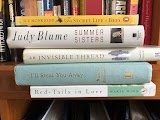I love the "Day in the Life" project. However, I want each student to create that for themselves. I want it to include their home life: getting up in the morning, getting ready, the bus ride in, breakfast, classes, lunch after school stuff- all of it. The good, the bad, and especially the ugly. I might make it a "A Week in the Life." That way we get a better picture of who they are and what is important to them. I did a similar project at my old high school and the kids loved it. At East we are required to stick to the New York State Modules, but I believe I can squeeze something in near the end in June.
BTW: I'm hitting "save" every few minutes or so. Boy, did I learn my lesson last week!
Oh man. I just discovered Spine Poetry! That's got my name all over it! I have a few heavy readers who will love it also. Who knows, maybe if I make it a required assignment some of the weaker readers just might check a book out. I'm in!

Well, it's too small and I can't figure out how to make it bigger and clear; it gets fuzzy if I make it bigger. I found my wife's books worked better than my John Grishams and my adventure non-fiction titles!
It reads: The Secret Life of Bees
Summer Sisters
An Invisible Thread
I'll Steal You Away
Red Tails In Love
Not bad, Huh?!! :)
I'm not too sure about Bookface, but if I see an old guy on the cover of a book (good luck) I'll give it a shot. So will my students after I hip them to the concept.
I did love the NY Times article it came from, "Oh Those Clever Librarians and Their #Bookface," and I clicked on the links. I liked the dual books idea and the lining up of several of the same books to create a visual effect. I was once on the cover of the daily paper here in Rochester (truth) and when we went out for dinner later that night my 9 year old daughter got a kick out of seeing half of my face over and over on a tiered news stand! "Hey, Dad! Look, there you are over and over and over!"
See you all on the flip flop! Cool Tools rule!
Hey, look! I tried one more save option and it worked! Yea, me!


